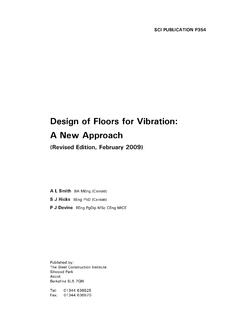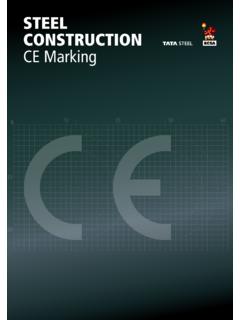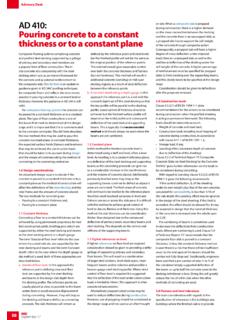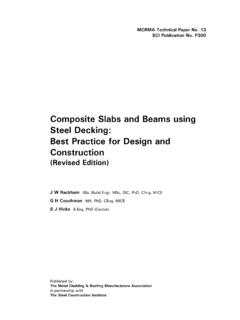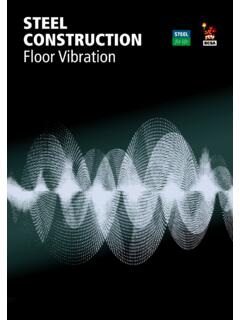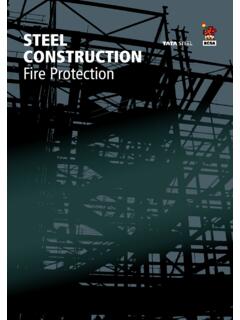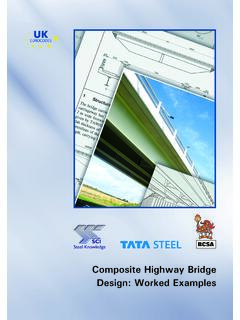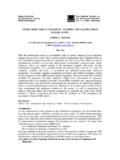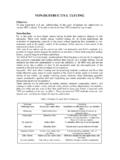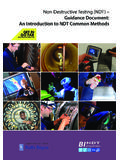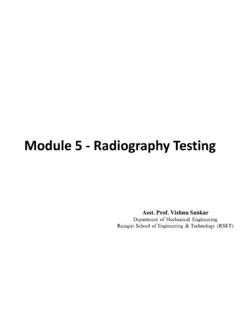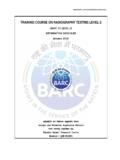Transcription of Guide to Weld Inspection for Structural Steelwork
1 Guide to Weld Inspection for Structural Steelwork BCSA Publication No. 54/12. Guide to Weld Inspection for Structural Steelwork BCSA Publication No. 54/12. BCSA Limited is the national organisation for the steel construction Apart from any fair dealing for the purposes of research or private industry: its Member companies undertake the design, fabrication study or criticism or review, as permitted under the Copyright Design and erection of Steelwork for all forms of construction in building and and Patents Act 1988, this publication may not be reproduced, civil engineering. Associate Members are those principal companies stored or transmitted in any form by any means without the prior involved in the supply to all or some Members of components, permission of the publishers or in the case of reprographic materials or products.
2 Corporate Members are clients, professional reproduction only in accordance with the terms of the licences offices, educational establishments etc., which support the issued by the UK Copyright Licensing Agency, or in accordance with development of national specifications, quality, fabrication and the terms of licences issued by the appropriate Reproduction Rights Organisation outside the UK. erection techniques, overall industry efficiency and good practice. Enquiries concerning reproduction outside the terms stated here The British Constructional Steelwork Association Limited should be sent to the publishers, The British Constructional 4 Whitehall Court, Westminster, London SW1A 2ES. Steelwork Association Ltd. at the address given below.
3 Telephone: +44 (0) 20 7839 8566, Fax: +44 (0) 20 7976 1634. Although care has been taken to ensure, to the best of our Website: knowledge, that all data and information contained herein are accurate to the extent that they relate to either matters of fact or accepted practice or matters of opinion at the time of publication, The British Constructional Steelwork Association Limited, the authors and the reviewers assume no responsibility for any errors in The European operations of Tata Steel comprise Europe's second or misinterpretations of such data and/or information of any loss or largest steel producer. With main steelmaking operations in the UK damage arising from or related to their use. and the Netherlands, they supply steel and related services to the construction, automotive, packaging, lifting & excavating, energy & Publications supplied to members of the BCSA at a discount are not for resale by them.
4 Power, and other demanding markets worldwide. Tata Steel is one of the world's top ten steel producers. The combined group has an The British Constructional Steelwork Association Ltd., aggregate crude steel capacity of more than 28 million tonnes and 4, Whitehall Court, Westminster, London SW1A 2ES. approximately 80,000 employees across four continents. Telephone: +44 (0)20 7839 8566. Fax: +44 (0)20 7976 1634. Tata Steel E-mail: PO Box 1, Scunthorpe, North Lincolnshire, DN16 1BP. Website: Telephone: +44(0) 1724 404040. Email: Publication Number 54/12. Website: ISBN 10: 1-85073-064-4. ISBN 13: 978-1-85073-064-4. Acknowledgements British Library Cataloguing-in-Publication Data This publication has been produced with the special assistance of: A catalogue record for this book is available from the British Library Mr Dean Baker Severfield-Rowen Plc The British Constructional Steelwork Association Ltd.
5 Mr William Ervig Mabey-Bridge Printed by: Kovic Design Limited. Mr Jeff Garner BCSA (until 2011). Mr Johann Krancioch Sandberg LLP. Mr David Moore BCSA. Dr Roger Pope BCSA Consultant Summary This publication gives guidance on weld Inspection for Structural Steelwork . It explains how techniques for weld Inspection and testing are used to identify and characterise defects that can arise in Structural steel components. It also explains the causes of such defects and measures that may be taken to avoid them. The guidance is intended for use by persons undertaking or responsible for weld Inspection in fabrication facilities manufacturing Structural steel components that are designed for static loading. This technical knowledge is a prerequisite for persons identified as responsible for welding coordination by manufacturers of Structural steel components.
6 4. Guide TO WELD Inspection FOR Structural Steelwork . Contents 1 Introduction .. 6. 2 Scope .. 7. 3 Overview .. 8. NDT/NDE Methods .. 8. Imperfections and Defects .. 8. destructive testing .. 9. Acceptance Criteria .. 9. Inspection and Test Plan .. 9. 4 Visual Inspection of Welds .. 11. Introduction .. 11. Welding Inspection Personnel .. 11. Conditions for Visual Inspection .. 11. Visual Inspection Duties .. 11. 5 Weld Defects and Causes .. 15. Weld Technique .. 15. Weld Geometry, Shape and Dimensions .. 15. Cavities .. 17. Cracks .. 18. Solid Inclusions .. 20. Lack of Fusion or Penetration .. 21. 6 NSSS Weld Acceptance Criteria .. 23. 5. Guide TO WELD Inspection FOR Structural Steelwork . 1 Introduction BS EN 1090-2 Execution of steel structures and aluminium structures.
7 Part 2: Technical requirements for the execution of steel structures requires that a Responsible Welding Coordinator (RWC) be appointed by manufacturers of welded Structural steel components in Execution Classes 2, 3 or 4 (EXC2, EXC3 or EXC4). The BCSA's Guide to the CE Marking of Structural Steelwork explains the guidance given to Notified Bodies certifying factory production control (FPC) systems for manufacturing welded Structural steel components which states that: With respect to the processes being used, the Execution Class for the products being produced, the constituent products being welded and the welding consumables being used, the assessment of the RWC's competence shall include the following checks with respect to the RWC's ability to coordinate the processes etc within the FPC System: During a technical discussion, check the knowledge of the welding coordinator(s) about the relevant standards, regulations and specifications to be observed.
8 Check the ability of the welding coordinator(s) to detect and assess defects, to instruct repairs and to know how to avoid defects. This publication has been prepared to provide guidance on how to detect and assess defects and how to avoid defects in welded Structural steel components that are designed for static loading. 6. Guide TO WELD Inspection FOR Structural Steelwork . 2 Scope This Guide is complementary to the BCSA's National Structural Steelwork Specification for Building Construction 5th Edition CE. Marking Version (NSSS) which states that it can be used for all types of building construction designed for static loading. It is based on execution of Structural Steelwork in Execution Class 2 according to BS EN 1090-2.
9 It is not intended to be used for Steelwork in dynamically or seismically loaded structures or if fatigue is a factor unless appropriate amendments are made . The Guide is generally focused on the types of defects that are likely to arise in steels in strength grades up to S355 that are welded using the following welding processes: 111: Manual metal-arc welding (metal-arc welding with covered electrode); or 135: Metal active gas welding; MAG-welding. This guidance is also complementary to BCSA's Typical Welding Procedures for Structural Steelwork . 7. Guide TO WELD Inspection FOR Structural Steelwork . 3 Overview NDT/NDE Methods Imperfections and Defects BS EN 1090-2 states: All welds exhibit some imperfections in terms of either shape or metallic discontinuities.
10 The purpose of testing is to be able to Non- destructive testing (NDT) methods shall be selected in characterise such imperfections in order to determine whether they accordance with EN 12062 by personnel qualified according to are defects that require remedial action. The remedial action may Level 3 as defined in EN 473. Generally ultrasonic testing or necessitate repair of the weld or adjustment of the welding process radiographic testing applies to butt welds and penetrant testing parameters or both. This occurs when the imperfections exceed the or magnetic particle Inspection applies to fillet welds. acceptance criteria specified in the standard. BS EN ISO 6520-1. BS EN 12062 Non- destructive examination of welds General rules provides the following definitions: for metallic materials refers to the following non- destructive Imperfection: any deviation from the ideal weld.
